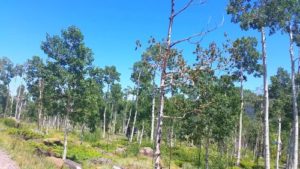I’m something of a science buff. I’m no expert on anything, really, but I like to read articles on science topics. I’m not sure when I first heard of Pando. It’s a quaking aspen colony in the Fishlake National Forest and it’s the most massive single organism in the world (that we know of at this point, at least). Not the largest in area — that’s a fungus in eastern Oregon — but the, one source I read says, “heaviest,” which is I guess accurate in Earth’s gravity. Mass, though, isn’t just weight. It’s the amount of “stuff” that compose the object.
Pando has one root system and thousands of stems. The scientists suspected that Pando was one big tree and once they could examine its DNA, they saw that every cell of every stem for over a hundred acres had the exact same DNA. And not like all Cavendish banana plants have the same DNA (though they do). From what I can tell, the epigenetics, the changes in the expression of the genes, are the same, as well. And that would basically not happen from cloned plants.

On the slightly less uplifting front, Pando may be dying. It’s had a good run; scientists estimate that it’s 80,000 years old at a minimum, but people would like to help extend its life. They’ve fenced off portions and are experimenting on them to see what it would take to keep the tree alive. So I guess I’m glad I got to see it when I did.
While we were down there, we decided to check out Fish Lake itself. And Fish Lake was amazing. It was the bluest lake that I think I’ve ever seen. I joked with Alex that they put Ty-D-Bol in the lake. Unfortunately, Alex is too young to remember Ty-D-Bol so the joke was lost on him.
So we drove around the lake for a while, marveling at the blue color (which is, of course, totally natural, the blue color is something to do with limestone in the water) and taking pictures. Then I girded my loins for the trip back to Salt Lake City.
Why did I have to gird my loins? Well, we drove down from Salt Lake City immediately after landing and getting our bags and rental car. This trip is how I discovered that the seat of the car was incompatible with my seat. As a result, drives that Google Maps said would take seven hours tended to take nine or more. I ended up having to stop every hour and a half to two hours to rest my rear end.
